Finding the right lampshades for your needs sounds like it should be simple – just choose something that looks good. But when you start considering all your options, you soon find it’s more complicated than that.
How do you know if you’re picking the right style for your rooms? What about if the base doesn’t match the shade itself? What if it’s the wrong width?
There’s good news, though: once you know the basic principles of shade selection, you’re well on your way to making the right decision. It’s both an art and a science.
Are you struggling to choose the right shade for your interiors? Here’s our comprehensive guide covering all of the glass shades we stock in-store. Read on to learn more.
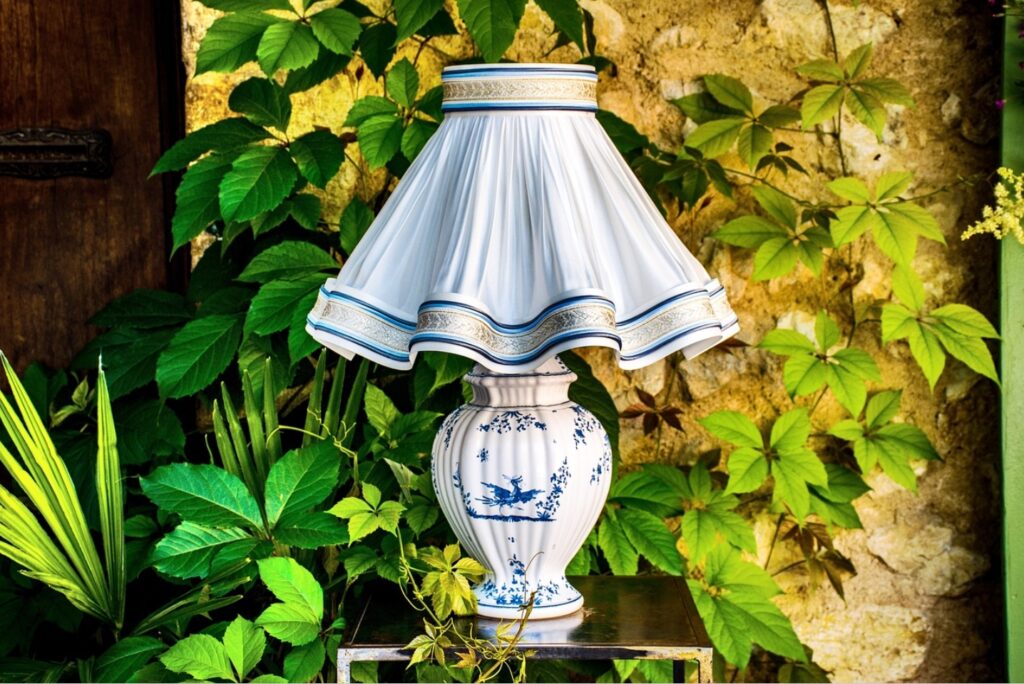
Consider The Style
Lampshades come in a variety of beautiful styles. But you should avoid using any old design. Your lampshade should complement your interiors.
Antique glass shades mostly hail from the 19th century. As homes became electrified, manufacturers began experimenting with glass shades en masse, creating all sorts of beautiful designs. The hope was to use glass to create a romantic atmosphere in the home and ensure maximum illumination.
Glass shades were originally for small lamps burning kerosene. Many had cylindrical shapes to permit the flow of air necessary to keep the flame alive.
With electricity, though, demand ramped up. Lamp makers started including colored glass, cutting intricate patterns, and including artwork, like flowers. Tiffany Studios created some of the most recognizable art nouveau designs using tiny glass pieces held together with lead strips.
Eventually, people got a massive choice of shades, some of which we describe in more detail below.
Chimney Glass Shades
Chimney glass shades are a type of shade that – you guessed it – looks a bit like a chimney. Often, these have a broader, bulging midsection for the lightbulb and then a narrower top and bottom.
The design has been with us for centuries. Oil lamp manufacturers preferred it because it allowed their devices to suck in air from below and then expel fumes above, like a regular chimney.
Of course, chimney glass shades are purely aesthetic for electric bulbs. But their unique design pairs well with shaker interiors, shabby chic, rustic, and renaissance interiors.
Hurricane Glass Shades
Hurricane glass shades are very similar in style to chimney shades, usually featuring a bulbous mid-section around the light source, finishing in an open aperture at the top. Like their cousins, they work well in traditional and shabby chic interiors.
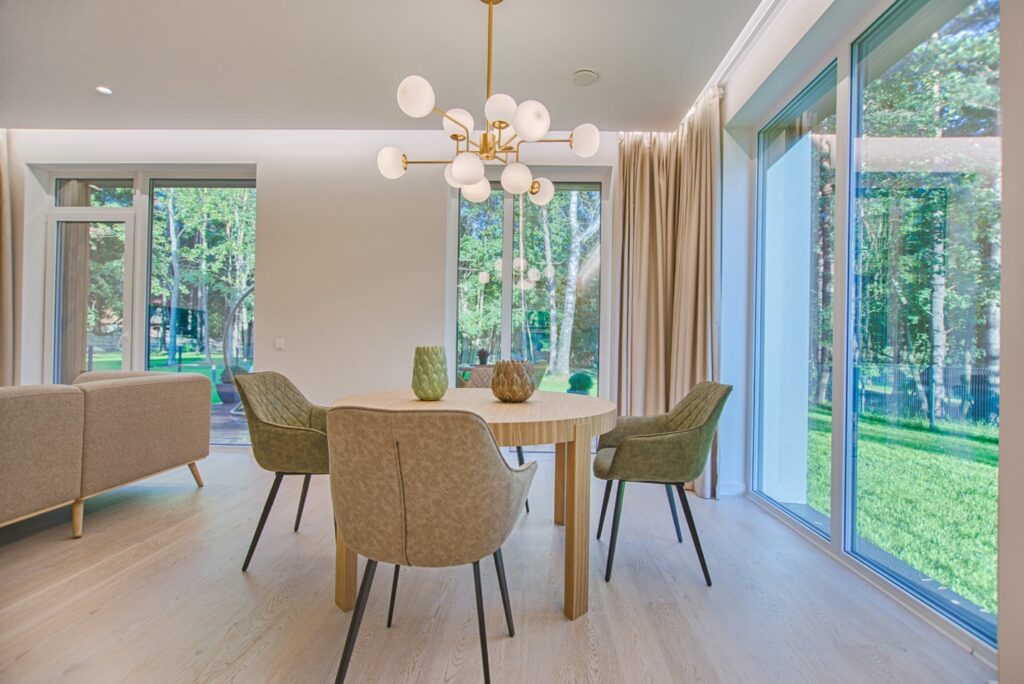
Ball Glass Shades
Ball and dome glass shades are a product of the Victorian era. These form a spheroidal shape around the bulb.
Shades for ceiling lights encase the bulb entirely. Those designed for freestanding lamps do the same, except for small openings at the top and bottom for fittings.
Plain ball glass shades can work well in most contemporary interiors. Patterned versions are best reserved for antique enthusiasts.
Many ball glass shades are also neckless glass shades. Here, the shade hangs on an inside plate when vertically orientated. An outside clamp – often made of brass – holds both the inside plate and shade in place.
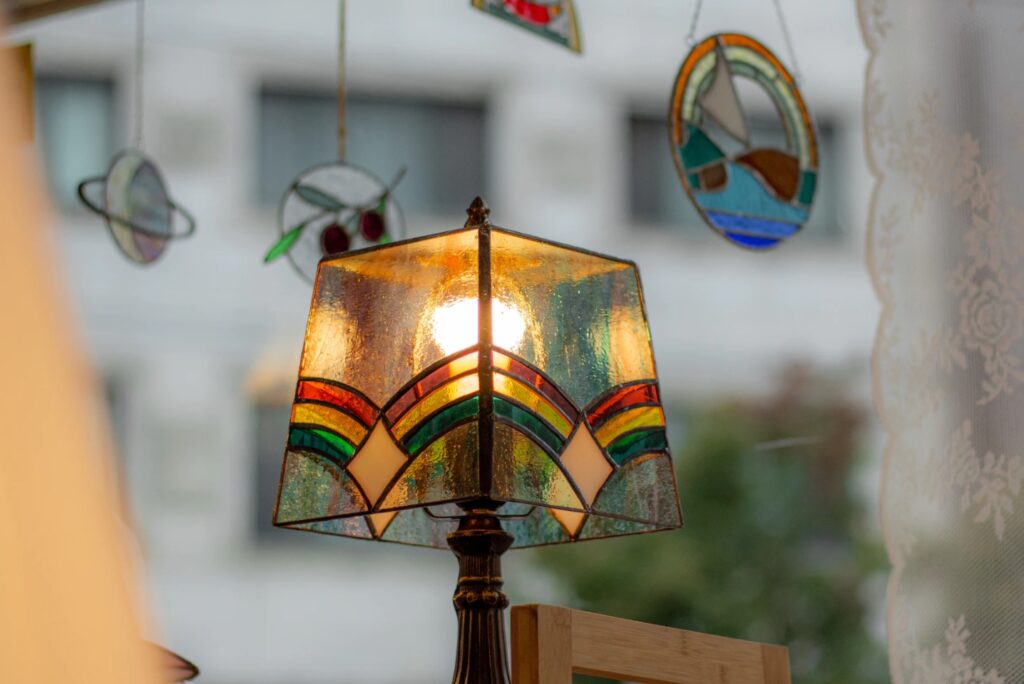
Painted Glass Shades
Painted glass shades are among the most visually stunning glass lampshades. When you switch on the light, they scatter colored light throughout your rooms, creating a unique mood.
The art of painting glass lampshades originated in Europe in the 1730s when the cost of coloring techniques started to come down. They hit the big time in the 1890s after Philip J. Handel popularized a style of reverse painting.
Painted glass shades are ideal in homes with traditional décor, antique furniture, and hardwood flooring. They look great either suspended from the ceiling or atop a pedestal table or sideboard.
Reflector Glass Shades
Reflector glass shades are a modern incarnation of the traditional glass shades. They work on the principle of diffusion, taking regular light emitted from the bulb and then scattering it around the room.
These shades are often modern and minimalist in appearance, making them suitable for contemporary homes. They work particularly well when paired with floor lamps.
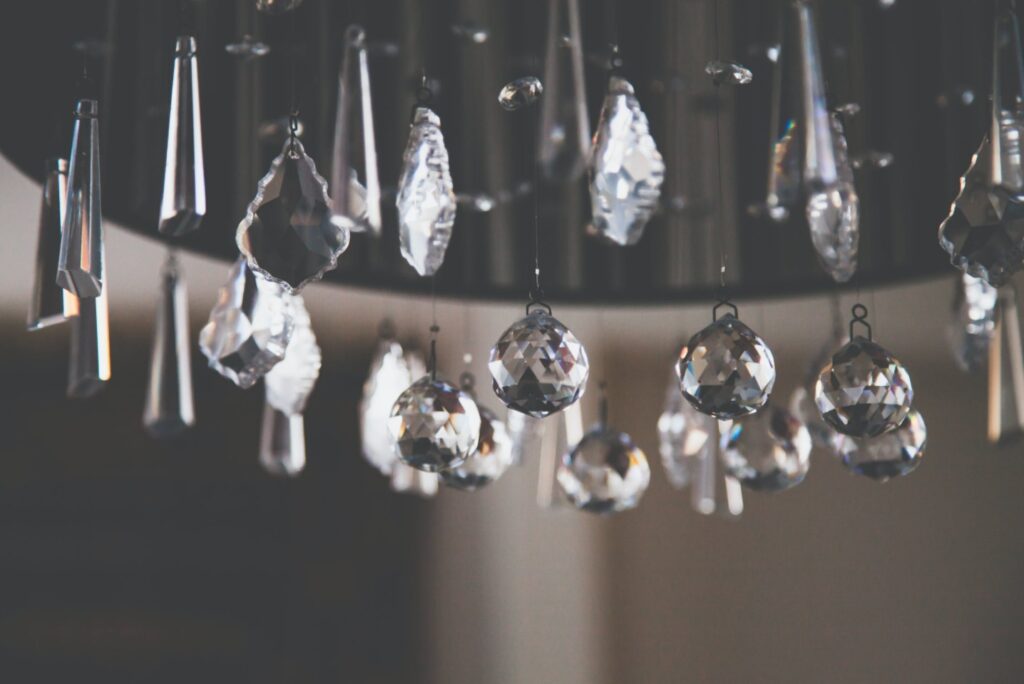
Chandelier Glass Shades
Chandelier glass shades are among the most elaborate and intricate glass shades that you can buy – ideal for anyone looking to create a luxe look in their interiors. Most examples feature glass patterns reminiscent of traditional chandeliers. Designers often include dozens of cut crystals suspended on brass or aluminum hooks, scattering light in interesting patterns across your walls.

Torchiere Glass Shades
Torchiere glass shades look antique, but they’re something of a modern invention. The bulb sits at the bottom of a funnel-shaped piece of glass that extends outwards, eventually fanning out beautifully, creating a torch-like appearance.
Torchiere shades are available in a wide variety of colors and patterns. However, the style’s overall shape is neutral, allowing you to pair them with virtually any interior. They’re just as at home in art deco, classical, traditional, modern, and zen interiors.
Flat Glass Shades
Flat glass shades are one of the most beautiful and retro-looking shades available on the market right now. Their saucer-shaped design makes them instantly recognizable.
These shades allow the light bulb to sit proud of the shade itself, with a flat glass backing behind it. The shade can act as a partial diffuser, but the main effect is the striking style.
Flat glass shades are ideal for anyone wanting to create a retro or antique-style interior. They give your rooms an other-worldly feel.
Choose Your Type Of Glass
Lampshades also come in various glass types, each with their own fascinating history and provenance.
Frosted Glass Shades
Companies like the Pairpoint Corporation began experimenting with ribbed glass that uniquely diffused light at the start of the 20th century. Following that, manufacturers started blasting their glass shades with sand, eventually developing frosted glass. It was a powerful technology because it allowed vendors to selectively sand parts of the glass to create beautiful shapes and patterns.
Frosted glass shades are suitable for both modern and traditional homes. You can have modernist frosted shades with geometric patterns or antique-style versions that play on traditional forms from the pre-WWII era.
White Glass Shades
Many people want simple shades in their homes: something that will blend into the background, allowing other room features to shine. White glass is ideal for that.
In Venice, artists first made opaque white glass in the 16th century to compete with porcelain by adding opacifiers. Putting these in the melt led to the formation of non-transparent crystals that gave the glass its unique appearance. It looked like China but wasn’t.
White glass shades – also sometimes called opal glass shades – have a distinctly traditional aesthetic, especially those with floral detailing and patterning. However, plain, geometric, and symmetrical shades that use the material are available too.
Satin Glass shades
Satin glass made its first appearance in the US and Britain in the 1880s when manufacturers added hydrofluoric acid to their melts. Later in the 1970s, the Fenton Art Glass Company developed a technique that allowed satin glass mass production.
Satin glass looks similar to frosted glass, but with a slightly glossier finish. What’s more, because satin glass doesn’t rely on sandblasting, manufacturers can create more detailed finishes.
Again, satin glass styles go back more than one hundred years, meaning that you can use these shades in practically any interior.
Consider Your Holder
Strictly speaking, the word “lampshade” refers to the object that scatters the light from your bulb. It is separate from the fittings that keep in place. Thus, when choosing a shade, you will also need to consider holders.
Holder Materials
Glass shade holders come in a variety of materials.
Brass Shade Holders
Brass shade holders are standard in luxury lamps and use various mechanisms to hold the shade in place. Initially, manufacturers selected the metal for kerosene lamps. Only later did it make the transition to the electric lamps we know and love today.
You’ll often find brass in lampshade finials – the decorative caps that fit over the top of lamps, securing them in place. The metal is ideal for art deco, art moderne, art nouveau, Venetian, Tuscan, steampunk, shabby chic, and southwestern interiors, to name just a few.
Metal Shade Holders
Unlike brass, which is slightly golden, metal shade holders are silver-like in their coloration – though not usually lustrous. Most are made of aluminum, though some antiques may use iron or steel and are suitable for freestanding and tabletop lamps.
Holder Style
Lampshade holders also come in a variety of fitting types with varying levels of utility.
Harp Shade Holders
Harp shade holders are usually made of metal and come in two parts – a saddle fastened under the lamp socket and a lightweight frame that fits the saddle and extends outwards around the bulb, often connecting back together above it. Harp shade holders are the most common, mainly because of their versatility and compatibility with most lampstands.
Pipe Shade Holders
Pipe shade holders work differently. Here, the shade fixes to the stand itself, without any additional interlaying metalwork. Pipe-style shades, therefore, have to be self-supporting above the point of connection. Often, they screw into position.
This type of fitting is helpful if you want to orientate your shades at interesting angles. Pipe fittings allow you to support shades from the bottom and the top, making them ideal for wall lamps.
Clip-on Shade Holders
Finally, you might consider clip-on shade holders if you plan on changing your décor regularly. Unlike harp shade holders, clip-on shades don’t fit the lampstand. Instead, they attach to the bulb itself, providing greater compatibility. They usually comprise a safe clasp that wraps around the bulb with a universal screw on the top, designed for multiple adapters. These are ideal if you’re unsure what type of shade you want long-term because they let you experiment. They are particularly useful for floor lamp glass shades you regularly move from room to room.
Choose A Shade That Flatters Your Base
The physical size of the shade and its height and width versus the base significantly affect how it will appear.
Here are some rules you’ll want to follow. (Please note that these are general rules of thumb. There will always be exceptions).
- Get the height right. Ensure that the height of the shade is around 40 percent of the lamp’s total height.
- Get the width right. You want the shade’s width to be around twice that of the base at its widest point. If it is too broad, it’ll look clumsy and out of place.
Once you have worked out roughly the right size of shade you need for your lamp, the next step is to measure the shade using a tape measure. Don’t worry if you fall in love with a shade that doesn’t fit your existing base; you can always find another that does.
Some shades – such as flat shades – won’t fulfill the above criteria. That’s okay. In these cases, it is down to your judgment to decide what works and what doesn’t. Even if you can’t match a shade in the vertical direction, you may be able to do so horizontally, and vice versa, improving symmetry.
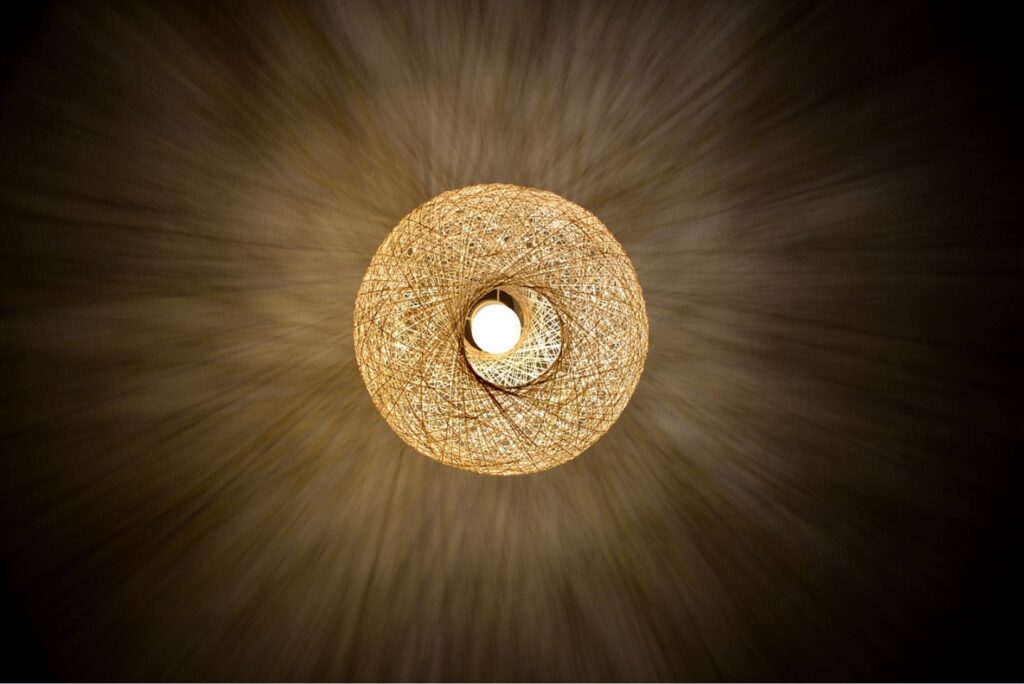
Find The Perfect Shade For You
Shades have a long history. In the 1920s, glass innovators worldwide experimented with introducing flecks and streaks, giving their lamps vibrant hues. Then, later in the 20th century, industry leaders like the Fenton glass Company tried to recreate some of the glories of the Victorian era, modeling designs after gas kerosene lamps. Following WWII, modernist and geometric designs came to the fore, changing things yet again.
Today, therefore, the range of styles available is tremendous. We can help you choose one that complements your interiors perfectly. Come to our shop and see all of these lamp styles for yourself.

